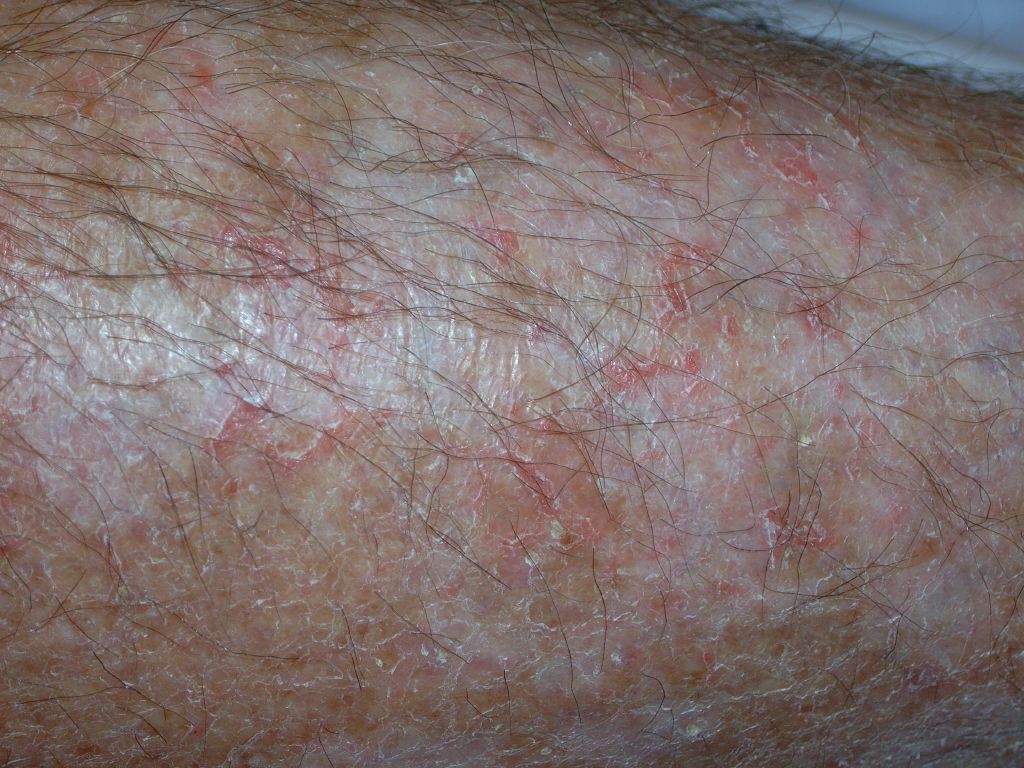[1]
Norman RA. Xerosis and pruritus in the elderly: recognition and management. Dermatologic therapy. 2003:16(3):254-9
[PubMed PMID: 14510882]
[2]
Sparsa A, Liozon E, Boulinguez S, Bordessoule D, Vidal E, Bonnetblanc JM, Bedane C. Generalized eczema craquele as a presenting feature of systemic lymphoma: report of seven cases. Acta dermato-venereologica. 2005:85(4):333-6
[PubMed PMID: 16191855]
Level 3 (low-level) evidence
[3]
Chu CH, Chou CY, Lin FL. Generalized eczema craquelé (asteatotic dermatitis) associated with pemetrexed treatment. Journal of the European Academy of Dermatology and Venereology : JEADV. 2016 Oct:30(10):e81-e83. doi: 10.1111/jdv.13329. Epub 2015 Sep 28
[PubMed PMID: 26416293]
[4]
Vale EPBMD, Rodrigues CHL, Kallas FE, Fucuta PDS. Eczema craquelé associated with antiviral treatment for chronic hepatitis C. Anais brasileiros de dermatologia. 2017 May-Jun:92(3):436-437. doi: 10.1590/abd1806-4841.20174464. Epub
[PubMed PMID: 29186272]
[5]
Yang CS, Lott JP, Bunick CG, Bolognia JL. Eczema craquelé associated with nephrotic syndrome. JAAD case reports. 2016 May:2(3):241-3. doi: 10.1016/j.jdcr.2016.04.008. Epub 2016 Jun 24
[PubMed PMID: 27408932]
Level 3 (low-level) evidence
[6]
Patrizi A, Gurioli C, Tengattini V, Bardazzi F. Eczema craquelé, an uncommon clinical manifestation of myxedema. Journal der Deutschen Dermatologischen Gesellschaft = Journal of the German Society of Dermatology : JDDG. 2015 May:13(5):453-4. doi: 10.1111/ddg.12587. Epub
[PubMed PMID: 25918092]
[7]
Weismann K, Wadskov S, Mikkelsen HI, Knudsen L, Christensen KC, Storgaard L. Acquired zinc deficiency dermatosis in man. Archives of dermatology. 1978 Oct:114(10):1509-11
[PubMed PMID: 718188]
[8]
Warin AP. Eczéma craquelé as the presenting feature of myxoedema. The British journal of dermatology. 1973 Sep:89(3):289-91
[PubMed PMID: 4743432]
[9]
Greist MC, Epinette WW. Cimetidine-induced xerosis and asteatotic dermatitis. Archives of dermatology. 1982 Apr:118(4):253-4
[PubMed PMID: 6461297]
[10]
Barker DJ, Cotterill JA. Generalized eczéma craquelé as a presenting feature of lymphoma. The British journal of dermatology. 1977 Sep:97(3):323-6
[PubMed PMID: 921903]
[11]
Ward S. Eczema and dry skin in older people: identification and management. British journal of community nursing. 2005 Oct:10(10):453-6
[PubMed PMID: 16234740]
[12]
Wang X, Li L, Shi X, Zhou P, Shen Y. Itching and its related factors in subtypes of eczema: a cross-sectional multicenter study in tertiary hospitals of China. Scientific reports. 2018 Jul 17:8(1):10754. doi: 10.1038/s41598-018-28828-6. Epub 2018 Jul 17
[PubMed PMID: 30018382]
Level 2 (mid-level) evidence
[13]
Polat M, İlhan MN. Dermatological Complaints of the Elderly Attending a Dermatology Outpatient Clinic in Turkey: A Prospective Study over a One-year Period. Acta dermatovenerologica Croatica : ADC. 2015:23(4):277-81
[PubMed PMID: 26724880]
[14]
Akimoto K, Yoshikawa N, Higaki Y, Kawashima M, Imokawa G. Quantitative analysis of stratum corneum lipids in xerosis and asteatotic eczema. The Journal of dermatology. 1993 Jan:20(1):1-6
[PubMed PMID: 8482746]
[15]
Cassler NM, Burris AM, Nguyen JC. Asteatotic eczema in hypoesthetic skin: a case series. JAMA dermatology. 2014 Oct:150(10):1088-90. doi: 10.1001/jamadermatol.2014.394. Epub
[PubMed PMID: 25029204]
Level 2 (mid-level) evidence
[16]
Ng SY, Begum S, Chong SY. Does Order of Application of Emollient and Topical Corticosteroids Make a Difference in the Severity of Atopic Eczema in Children? Pediatric dermatology. 2016 Mar-Apr:33(2):160-4. doi: 10.1111/pde.12758. Epub 2016 Feb 9
[PubMed PMID: 26856694]
[17]
Schulz P, Bunselmeyer B, Bräutigam M, Luger TA. Pimecrolimus cream 1% is effective in asteatotic eczema: results of a randomized, double-blind, vehicle-controlled study in 40 patients. Journal of the European Academy of Dermatology and Venereology : JEADV. 2007 Jan:21(1):90-4
[PubMed PMID: 17207174]
Level 1 (high-level) evidence
[18]
Miller DW, Koch SB, Yentzer BA, Clark AR, O'Neill JR, Fountain J, Weber TM, Fleischer AB Jr. An over-the-counter moisturizer is as clinically effective as, and more cost-effective than, prescription barrier creams in the treatment of children with mild-to-moderate atopic dermatitis: a randomized, controlled trial. Journal of drugs in dermatology : JDD. 2011 May:10(5):531-7
[PubMed PMID: 21533301]
Level 1 (high-level) evidence
[19]
Yuan C, Wang XM, Guichard A, Tan YM, Qian CY, Yang LJ, Humbert P. N-palmitoylethanolamine and N-acetylethanolamine are effective in asteatotic eczema: results of a randomized, double-blind, controlled study in 60 patients. Clinical interventions in aging. 2014:9():1163-9. doi: 10.2147/CIA.S65448. Epub 2014 Jul 17
[PubMed PMID: 25071367]
Level 2 (mid-level) evidence
[20]
Yamada S, Sawada Y, Ohmori S, Omoto D, Haruyama S, Kubo R, Yoshioka M, Nishio D, Nakamura M. Acute edema/cutaneous distension syndrome representing as eczéma craquelé-like change: A case and published work review. The Journal of dermatology. 2016 Jun:43(6):709-10. doi: 10.1111/1346-8138.13267. Epub 2016 Jan 18
[PubMed PMID: 26775716]
Level 3 (low-level) evidence
[21]
Bhushan M, Cox NH, Chalmers RJ. Eczéma craquelé resulting from acute oedema: a report of seven cases. The British journal of dermatology. 2001 Aug:145(2):355-7
[PubMed PMID: 11531813]
Level 3 (low-level) evidence
[22]
Kimura N, Nakagami G, Takehara K, Miura Y, Nakamura T, Kawashima M, Tsunemi Y, Sanada H. Prevalence of asteatosis and asteatotic eczema among elderly residents in facilities covered by long-term care insurance. The Journal of dermatology. 2013 Sep:40(9):770-1. doi: 10.1111/1346-8138.12217. Epub 2013 Jul 16
[PubMed PMID: 23855654]

